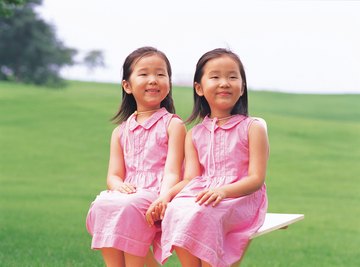
Freckles, freckles, everywhere: Mom and dad both have freckles and so do two of their kids. But wait -- the middle child is spotless — and so is the maternal grandmother. It seems like freckle-free skin skipped a generation. That may be true of the family’s phenotypes –- their observable characteristics — but their genetic information, or genotypes, will tell a different story. Unless a mutation has occurred, traits that seem to bypass generations are actually brought along in the genes. They just do not show up.
About Alleles
Genes are made from molecules of DNA (deoxyribonucleic acid, which contains an organism’s genetic instructions. These play a large role in determining an organism’s characteristics. Genes have variations, or alleles. During sexual reproduction, each parent passes along one allele for each gene. If those alleles are the same, the genotype shows that the trait is homozygous. A trait that is heterozygous has different alleles from each parent. The genotype determines what kind of information is passed down to offspring, and their phenotypes depend, in part, upon this information.
Winning Traits
Some alleles are dominant. These show up in an organism’s phenotype no matter if it is homozygous or heterozygous. For example, in humans, broad eyebrows, long eyelashes and dimples are dominant traits. Recessive traits appear when an organism has inherited two recessive alleles for a particular gene. A cleft chin is recessive, as are straight hairlines and connected eyebrows. However, not all traits follow these simple patterns. Genetics is complicated by interactions among genes, genes that affect multiple traits and influences from the environment.
Forget the Freckles
The freckle allele does show simple dominance, so if both parents have the freckled phenotype, their children are far more likely to have freckles than not. However, if both parents are heterozygous for the freckled trait, there is a chance that a child will get a “non-freckle” allele from each. This child’s phenotype will not show freckles. In this way, a child who does not match either parental phenotype can seem to take after a non-freckled grandparent. The trait appeared to “skip,” but the allele was there all along, in the genotype.
A Serious Skip
Although dominant and recessive traits are often seen in physical characteristics, they can also have serious consequences. For example, cystic fibrosis is a inherited disease characterized by symptoms in the respiratory and digestive systems. In severe cases, mucus clogs the lungs, causing frequent infections. CF is caused by a recessive allele. In order for the disease to appear in an individual’s phenotype, both parents must pass along the CF allele. Neither of the parents will show signs of the disease, because they are heterozygous for the trait, and the non-cystic fibrosis allele is dominant. Individuals such as these are called “carriers” of the recessive trait.
References
- Brooklyn College: Genotype and Phenotype Definition
- Arizona State University: Ask a Biologist: Solving a Genetic Mystery
- Fulton-Montgomery Community College: An Online Introduction to the Biology of Animals and Plants: Genetics
- Nature: Scitable: Inheritance of Traits by Offspring Follows Predictable Rules
- Palomar Community College District: Exceptions to Simple Inheritance
- University of Washington: Department of Statistics: Genotypes and Phenotypes
- The New York Times: The Claim: Twins Always Skip a Generation
About the Author
Living in upstate New York, Susan Sherwood is a researcher who has been writing within educational settings for more than 10 years. She has co-authored papers for Horizons Research, Inc. and the Capital Region Science Education Partnership. Sherwood has a Ph.D. in curriculum and instruction from the University at Albany.
Photo Credits
Hemera Technologies/Photos.com/Getty Images
